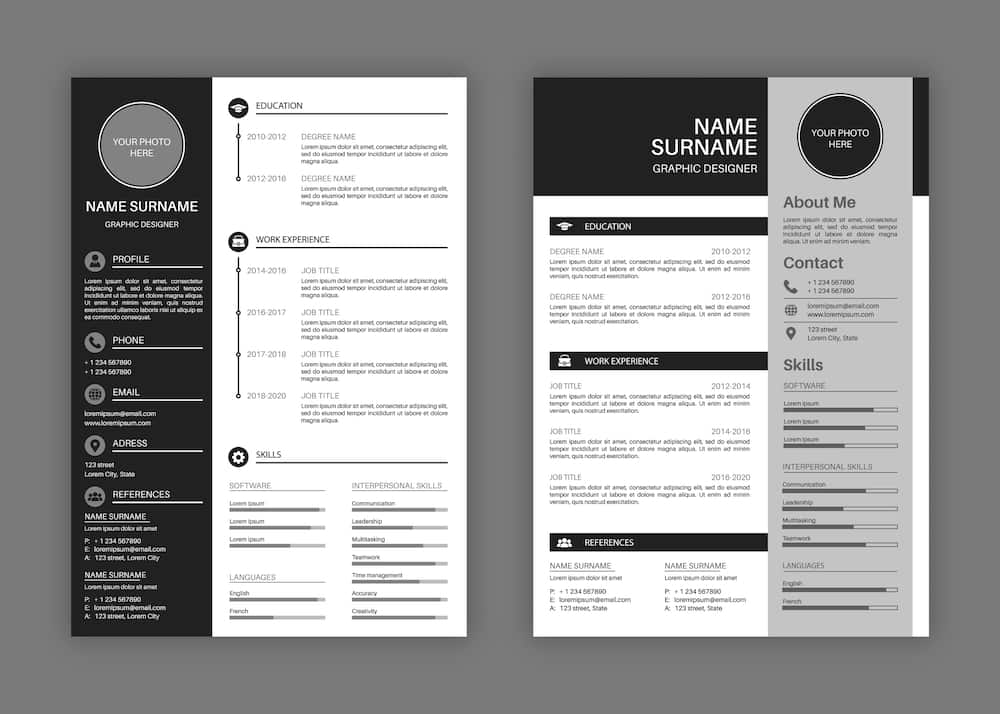Are you seeking guidance on writing a CV for an attachments program? Securing an internship might seem challenging, particularly when you have limited professional experience. Nonetheless, obtaining such an opportunity is essential for acquiring hands-on skills and establishing a base for your future career. Thus, crafting a persuasive resume that showcases your abilities and eagerness to learn could be pivotal in capturing the interest of prospective employers.

An impressive resume goes beyond being merely formal; it acts as your ticket to career prospects. It functions as an initial impression, grabbing the attention of possible employers and distinguishing you from competing applicants.
Advice on crafting a CV for an internship with limited experience
Crafting a CV with limited work experience might seem difficult yet remains entirely feasible. Below are several suggestions to assist you in developing an excellent CV tailored for college students:
Emphasise on your education
Provide information about your degree, related courses taken, academic honors, and any significant projects or research connected to the position you’re applying for. This demonstrates your expertise and passion for the subject area.
Highlight your most transferable skills
Despite lacking professional work experience, you probably possess skills that can be valuable in different situations. Highlight softer skills such as communication, collaboration, problem-solving, and flexibility, and support these claims with instances from your academic endeavors, club memberships, or athletic pursuits.
Tailor your resume for the position
Customize your resume for each application by matching your experiences and abilities with what the job posting asks for. Incorporate key terms from the job description and emphasize how your past achievements make you well-suited for the position.
Utilize a professionally designed CV format.
Make sure your resume is professionally structured, simple to read, and free of errors. Utilize distinct headers and bullet points for quick browsing, and keep font styles and spacing uniform throughout.
What is the most effective resume format for students?
Crafting an effective resume is essential for students embarking on their professional paths. An excellent student resume highlights their educational accomplishments along with pertinent experiences and abilities that set them apart. While numerous student resumes serve as templates, these key components must be incorporated into a strong student resume:
1. Contact Information: Full legal name, phone number, email address, LinkedIn profile.
2. Professional Summary/Objective Statement: Briefly summarize your background, aspirations, and goals related to employment.
3. Education Section: List degrees pursued, institutions attended including expected graduation date, GPA if above 3.0.
4. Relevant Coursework/Projects: Highlight classes or projects aligned closely with job targets.
5. Experience: Include internships, part-time jobs, volunteer work; emphasize duties performed and outcomes achieved.
6. Skills Inventory: Mention technical competencies like programming languages or software proficiency alongside soft skills such as communication or leadership qualities.
7. Extracurricular Activities & Achievements: Detail involvement in clubs, sports teams, awards received, etc., demonstrating teamwork and commitment.
Incorporating all of these aspects will help create a standout resume tailored specifically for aspiring professionals at the start of their careers.
Contact details

This segment offers employers the essential data needed to reach out to you for interview arrangements or additional questions. Correct contact information guarantees that you won’t miss valuable job prospects because of poor communication. Ensure this portion includes the following details:
- Complete name: Provide your entire legally recognized name as it appears on official identification documents.
- Please supply a dependable telephone number at which you can readily be contacted.
- Use a professional email address, ideally one that incorporates your name.
- Current residence: Provide your present home address, or alternatively, share just your county, city, or town if you wish to maintain privacy regarding your complete address.
- Include a link to your LinkedIn profile if it is current and appropriate for a professional setting.
Profile summary
This part provides an overview of your credentials, work history, and career aspirations. It offers employers a quick glimpse into why you would be a solid candidate for the role. Include essential points like pertinent abilities, significant accomplishments, and professional ambitions customized to align with the specific job you're seeking.
Education
This part covers your educational history, typically a crucial factor for employers assessing how well you might fit into a position. It should encompass:
- Certification(s) attained: Explicitly mention the certification(s) you have acquired (for example, Bachelor of Science, Master of Arts).
- Include the title of the educational institutions where you studied.
- Start and End Dates: Please share the commencement and conclusion dates for every academic endeavor.
- Area of Study: Please indicate your primary field or discipline of study.
- Accomplishments and distinctions: Include notable academic honors, prizes, or acknowledgments (such as placement on the Dean's List, grants).
Work experience
This segment highlights your practical abilities, dependability, and professional contribution potential. Should you lack formal work experience, this part ought to encompass:
- Highlight your voluntary roles by emphasizing the duties you undertook and the accomplishments you achieved during this time.
- Include details about your participation in extracurricular activities such as club memberships, athletic teams, or organizations where you have shown leadership, worked well with others, and developed important abilities.
- Projects: Mention any pertinent academic or personal initiatives related to the position, detailing your responsibilities and the abilities you utilized or honed.
- Freelance or part-time employment: Include details of any freelance projects or part-time roles you've had, regardless of whether they align with your target industry.
Skills
This part needs to emphasize the particular competencies and specialized knowledge that qualify you for the job. It gives employers an easy way to gauge if you possess the essential skills required for the internship position. Include:
- Technical Skills: Enumerate all of your applicable technical competencies, including expertise with particular software, command over programming languages, or familiarity with key tools and technologies related to the position.
- Highlight Soft Skills: Emphasize your ability to communicate effectively, work well in teams, solve problems, and lead others.
- Certifications and Training: List pertinent certificates, educational courses, or professional development programs that strengthen your credentials.
- If relevant, mention the languages you know along with your skill levels.
Achievements
This section highlights your achievements and your capability to produce tangible outcomes, distinguishing you from other applicants. It offers clear proof of your abilities and triumphs, illustrating the possible worth you could bring to an employer. This segment should encompass the following points:
- Awards and Honors: Please list any accolades or recognitions you have earned, including those from your studies or outside classroom engagements.
- Projects: Highlight significant initiatives you've finished, specifying your responsibilities and the outcomes or effects produced.
- Cited works: Include any references to published materials like journals, scholarly papers, or texts whenever relevant.
- Key Achievements: Emphasize your principal accomplishments, including hitting important goals or being part of notable successes.
Interest and hobbies
This segment offers a broader perspective on you as an applicant, highlighting your personal traits, interests, and activities beyond your professional or academic life. It assists employers in assessing whether you would be a good match for their company culture and gaining insight into different facets of your personality. This portion should encompass:
- Highlight hobbies related to the job or field, showing your passion and dedication.
- Interests: Highlight some of the top interests that can set you apart and generate engaging conversations.
- Innovative Ventures: Document any inventive endeavors like writing, visual arts, or musical compositions that showcase your innovative thinking and analytical skills.
Additional aspects to keep in mind while crafting a resume

When crafting your initial professional resume, adhere to these guidelines for layout and design:
-
- Summarize using brief, individual sentence fragments.
- Initiate each point with an action word.
- Keep statements concise and direct. - Make sure it’s simple to read.
- Keep it left-aligned.
-
Sure, I understand you want me to add line breaks after each paragraph when providing my responses. Here’s how I will approach this:
- When you provide text for paraphrasing,
- And it includes multiple paragraphs,
- I will ensure there is an extra line space between them.
This formatting guideline will be applied consistently moving forward. Feel free to share your text whenever ready! - Crafting text from my perspective but omitting personal pronouns presents an intriguing challenge. By steering clear of terms like "I," "me," and "my," one must find alternative ways to convey thoughts directly. This approach forces reliance on action verbs and descriptive phrases to imply participation without explicit mention. The result? A narrative style that focuses more intently on actions, observations, and dialogues rather than the individual behind them. It shifts emphasis towards universal experiences and collective understanding, making stories feel less about singular viewpoints and more encompassing—relatable across broader audiences.
- Don’t use tables
- Use either a font size of 11 points or 12 points.
- Set your line spacing to either 1.0 or 1.15 to make it easier to read.
Final word
Many newly graduated individuals and current students often seek advice and guidelines on crafting an effective CV for internships. Even without extensive professional experience, it’s entirely possible to create a compelling CV. Highlighting your academic achievements, pertinent abilities, and notable extracurricular successes can help demonstrate your value to prospective employers.
The .co.ke website has posted an article on how to write an official letter. Clear communication continues to be essential in every area of our lives, with formal letters being fundamental to professional exchanges.
No matter if you're submitting a job application, contacting a governmental body, or lodging a formal grievance, composing a precise and properly structured official letter can greatly impact the outcome. To learn how to pen such a letter that conveys your point efficiently, go through this piece.